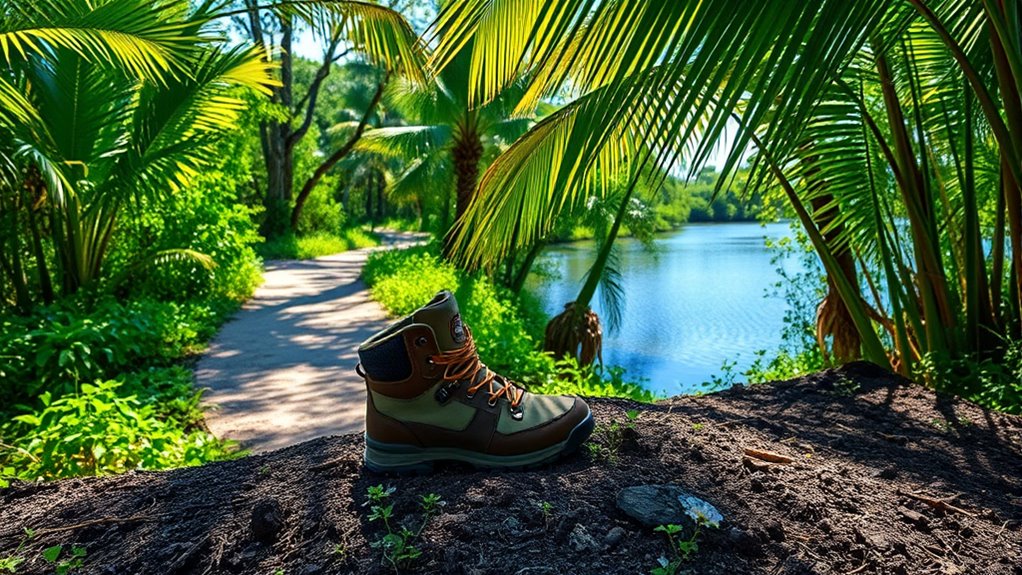Low-impact hiking in Everglades National Park lets you explore stunning landscapes while protecting fragile ecosystems. Stick to designated trails to prevent habitat damage and always carry out your trash to safeguard wildlife. Use binoculars to observe animals like herons and alligators from a respectful distance, minimizing noise to keep them undisturbed. Embrace mindful practices that foster a deeper connection with nature. You’ll discover even more tips to enhance your experience and preserve this unique environment.
Key Takeaways
- Stay on designated trails to protect the delicate ecosystems and prevent habitat damage in the Everglades.
- Use binoculars for wildlife observation, minimizing noise to avoid disturbing animals like herons and alligators.
- Carry out all trash and use biodegradable products to support conservation efforts and reduce environmental impact.
- Practice mindfulness during hikes to deepen your connection with nature and appreciate the intricate web of life.
- Embrace low-impact hiking techniques, recognizing that every step can influence the health of the ecosystem.

When you explore the vast beauty of Everglades National Park, it’s essential to tread lightly to preserve its unique ecosystem. This remarkable place is home to a diverse array of wildlife, and engaging in low-impact hiking not only enhances your experience but also contributes to the park’s conservation. As you set out on the trails, you’ll want to prioritize wildlife observation while ensuring that the natural environment remains undisturbed.
You’re likely to encounter a variety of species, from majestic herons to elusive alligators. By maintaining a respectful distance and minimizing noise, you increase your chances of witnessing these animals in their natural habitat. Remember, the goal is to appreciate the wildlife without interfering with their behavior. Bringing binoculars can enhance your experience, allowing you to observe from afar without causing stress to the animals.
Trail preservation is another critical aspect of low-impact hiking. When you stick to designated paths, you help protect fragile ecosystems that might be damaged by foot traffic. The Everglades is particularly sensitive; its wetlands and habitats rely on careful stewardship. If you stray off trails, you risk trampling delicate flora and disrupting the habitats of countless creatures. Keeping to established routes not only helps preserve the landscape but also ensures that you’re hiking safely through the park.
As you hike, take a moment to appreciate the intricate web of life surrounding you. Notice the way the trees sway in the gentle breeze or how the sunlight dances on the water’s surface. Being present allows you to connect with the environment on a deeper level. You might even consider journaling your thoughts or sketching the scenery; these activities foster a greater appreciation for the natural world. Additionally, engaging in outdoor activities with your dogs’ names can enhance your hiking experience, creating lasting memories together.
Make sure to carry out any trash you bring in, as litter can pose a threat to wildlife. Using biodegradable products and minimizing waste during your hike is another simple way to show respect for the park’s ecosystems. Educating yourself about the flora and fauna of the Everglades helps you understand the importance of conservation efforts.
Ultimately, low-impact hiking in Everglades National Park is about embracing the beauty and wonder of nature while being a responsible visitor. By prioritizing wildlife observation and trail preservation, you’re contributing to the lasting health of this extraordinary environment. Enjoy your adventure, and remember that every step you take matters.
Frequently Asked Questions
What Is the Best Time of Year for Hiking in the Everglades?
The best time for hiking in the Everglades is during the dry season, from December to April. This period offers pleasant temperatures and lower humidity, making your hikes more enjoyable. Keep in mind that these months are also the peak visitor months, so expect more crowds. If you prefer a quieter experience, consider hiking in the shoulder seasons of late November or early May, when the weather’s still good but fewer people are around.
Are There Any Guided Hikes Available in the Park?
Yes, there are guided hikes available in the park, like stepping onto a well-lit path in the dark. These guided tours often feature knowledgeable trail guides who share fascinating insights about the unique ecosystem. Imagine walking through the lush landscapes while learning about the diverse wildlife and plants that call the Everglades home. It’s a fantastic way to connect with nature and guarantee you don’t miss any hidden gems along the trails!
Can I Bring My Dog on Hiking Trails?
You can’t bring your dog on most hiking trails. However, if you’re in areas where dogs are allowed, keep in mind the leash requirements and dog etiquette. Always keep your dog on a leash, ideally six feet or shorter, to guarantee their safety and that of wildlife. Clean up after your pet to maintain a clean environment. Following these rules helps everyone enjoy the trails without hassle.
What Should I Do if I Encounter Wildlife While Hiking?
If you encounter wildlife while hiking, stay calm and keep your distance. Wildlife safety is vital, so avoid approaching or feeding the animals. Instead, observe them from a safe spot. If the animal seems aggressive, back away slowly and quietly—don’t run. Follow encounter protocols by making yourself appear larger and making noise if needed, but without startling the animal. Remember, respecting their space ensures both your safety and theirs.
Are There Restroom Facilities Available Along the Hiking Trails?
Yes, there are restroom facilities available along the hiking trails. You’ll find restrooms at key locations such as trailheads and visitor centers. It’s a good idea to plan your hikes around these restroom locations, especially on longer trails. Make sure to check maps or park information for specific restroom availability, as some areas might have limited facilities. Staying hydrated is important, but be mindful of your restroom options while you’re out exploring.
Conclusion
As you step softly through the stunning scenery of Everglades National Park, remember that mindful movements make a meaningful impact. By practicing low-impact hiking, you preserve this precious paradise for future generations. Cherish the chirping birds, the lush landscapes, and the serene swamps as you stroll. Your respectful rhythm contributes to the ecosystem’s enduring elegance. So, lace up your boots, embrace the beauty, and let your low-impact journey in the Everglades leave lasting legacies.










